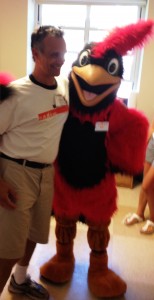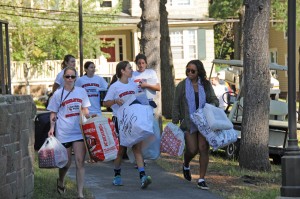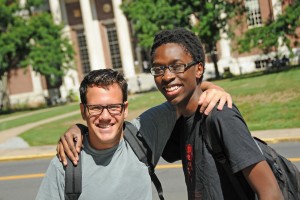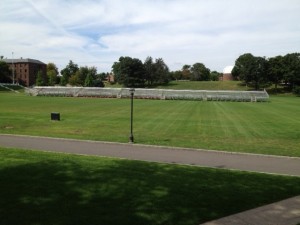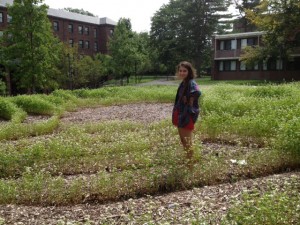What follows is a book review I published this weekend in The Washington Post of “Imagine: How Creativity Works,” by Jonah Lehrer. For years people have said that Wesleyan is a place for creative students, and recently we have tried to define more specifically how the work on our campus helps students develop their capacities for innovation.
A few days ago, applicants to Wes found out whether they have been invited to join the class of 2016. The competition for spots was very intense this year. With more than 10,000 applicants, most of whom are highly qualified, the process of putting together a class is increasingly difficult. We are looking for students who will thrive in the engaged, collaborative and imaginative campus culture here. Over the next four weeks many of the prospective pre-frosh will be visiting Wes, trying to determine if this will be their home and their launch pad for the next four years. The students who choose Wesleyan will likely be those who find that the dynamic student and faculty culture stimulates their own imaginative capacities. Creativity works at Wesleyan.
UPDATE:
Check out these recent articles on the student music scene at Wes:
http://www.usatodayeducate.com/staging/index.php/ccp/student-and-alumni-musicians-bring-wesleyan-wave-to-the-national-scene
http://www.billboard.biz/bbbiz/industry/backbeat/backbeat-fort-lean-rocks-santos-party-house-1006320752.story
Here’s the review, crossposted from washingtonpost.com:
Not many writers can make plausible links among musicians Bob Dylan, Yo-Yo Ma and David Byrne, animators at Pixar, neuroscientists at MIT, an amateur bartender in New York, entrepreneurs in Silicon Valley and Israeli army reservists. Not many reporters do research about an expert surfer who has Asperger’s, information theorists, industrial psychologists and artists. But Jonah Lehrer is such a writer-reporter, who weaves compelling and surprising connections based on detailed investigation and deep understanding. He says that working memory is an essential tool of the imagination, and his book is an excellent example of how a dynamic storehouse of captivating information feeds creative thinking and writing.
Lehrer begins with the story of a pop-culture breakthrough, the artistic reinvigoration that Dylan experienced when he wrote “Like a Rolling Stone.” Dylan was finishing a grueling tour schedule that had left him increasingly dissatisfied with making music. He decided to leave behind the madness of celebrity culture and the repetitive demands of pop performance. But once he was ensconced in Woodstock, N.Y., once he decided to stop trying to write songs, the great song came: “It’s like a ghost is writing a song,” he said. “It gives you the song and it goes away. You don’t know what it means.” Lehrer adds, “Once the ghost arrived, all Dylan wanted to do was get out of the way.”
Many of the stories that Lehrer recounts in the first few chapters stress the benefits of paying attention to internal mental processes that seem to come from out of the blue. We can learn to pay attention to our daydreams, to the thoughts or fantasies that seem nonsensical. Sometimes this attention must be very light, so that the stream of ideas and emotions flows, as when Ma feels his way into a new piece of music. Sometimes the attention must be very great, as when W.H. Auden (assisted by Benzedrine) focused on getting the words in a poem exactly right.
Lehrer explains some of the neuroscience behind these different modes of attentiveness. Making use of the power of the right hemisphere figures in, as does activating more energy from the prefrontal cortex to “direct the spotlight of attention.” He discusses experiments that explore which parts of the brain seem most active in different kinds of pursuits. For example, as the brain develops in childhood, the power to inhibit our flights of fancy grows. But as inhibition and focus increase, the capacity to improvise seems to diminish.
Lehrer notes that modern science has given new names to ideas that philosophers have been exploring for a very long time. Despite the fancy terminology, I found the anecdotes about scientific experiments less interesting than the anecdotes about poets, artists, surfers and inventors. That’s partly because the science stories seem to overreach, pretending to offer explanations for creativity by finding precise locations for the multitudinous connections that the brain generates. In an organ with the networking plasticity of the brain, location might not explain so much.
The last three chapters move from individuals to contexts. Lehrer offers fascinating accounts of why cities generate intense creative work and why certain urban-planning principles that emphasize heterogeneity (think Jane Jacobs) are so powerful. He shows us why teams that “are a mixture of the familiar and the unexpected,” such as those at Pixar, are the most innovative. Too much strangeness, and things fall apart. Too much closeness, and the generative spark is never struck.
Lehrer shows why brainstorming usually fails to result in real innovation because nobody is pushing back on bad ideas. “The only way to maximize creativity . . . is to encourage a candid discussion of mistakes. . . . We can only get it right when we talk about what we got wrong.” Or, as Lee Unkrich, a Pixar director, put it: “We just want to screw up as quickly as possible. We want to fail fast. And then we want to fix it. Together.”
Lehrer concludes with a discussion of why certain epochs seem to be more creative than others. Culture, he says, determines creative output, and it is through sharing information and making connections that we maximize that output. He quotes Harvard economist Edward Glaeser, who emphasizes that “even in this age of technology, we still get smart being around other smart people.”
Glaeser and Lehrer are showing why cities remain so important, but as the president of a university, I can also see how this applies to our campuses. Students and faculty seek the inspiration that is available all over campus, and that’s why so much learning happens outside the classroom. Sitting by yourself with your computer, even if you have access to thousands of Facebook “friends,” just isn’t the same as being in a creative, cosmopolitan culture in which new connections are continually (and surprisingly) formed.
“Imagine” doesn’t offer a prescription for how we are to become more imaginative, but it does emphasize some key ingredients of a creative culture: taking education seriously, increasing possibilities for human mixing and cultivating a willingness to take risks. Lehrer practices what he preaches, showing an appetite for learning, a determined effort to cross fields and disciplines, and a delight in exploring new possibilities. Reading his book exercises the imagination; the rest is up to us.
